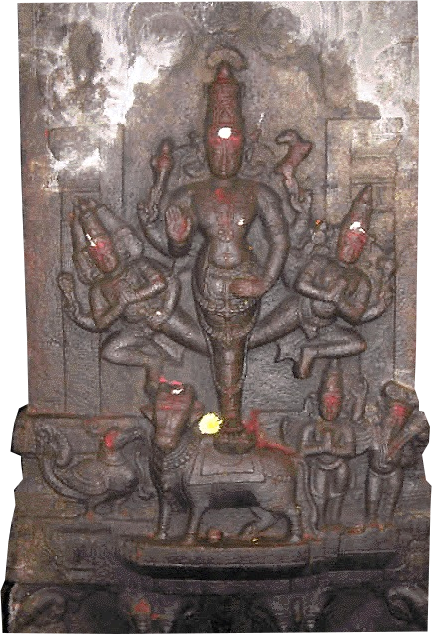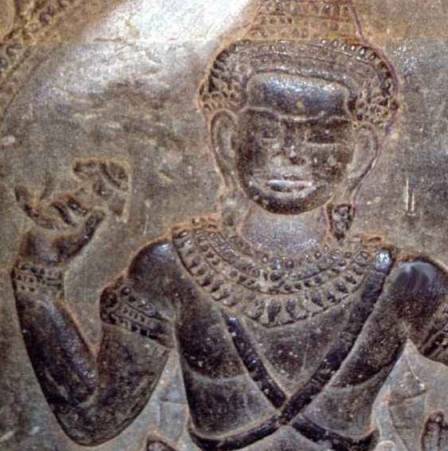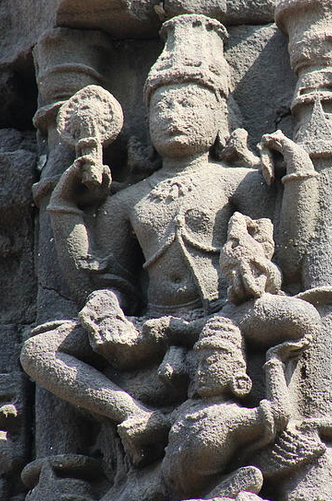Ancient Psychedelia: Alien Gods & Mushroom Goddesses
Online Book - Chapter 5, Page 60
Back to Online Book Mainpage / Next Page (Chapter 5, Page 61)
 (17a) Shiva  (17c) Shiva. Angkor Wat The hermaphroditic deity pictured in alchemical texts actually has a history going back to India in the form of Ardhanarishvara, a composite of Shiva and Parvati. The earliest imagery of this deity dates to the Kushan period of the first century AD, though the presence of Ardhanarishvara dates back to the Puranas. Ardhanarishvara could be said to be the embodiment of the essence of both male and female energies and the perfection of their integration or the idea that male and female cannot be separated. The true meaning relates to the mushroom’s ability to procreate from itself, being a hermaphroditic fruiting. Goddess does not make mistakes, even when she creates hermaphrodites. |
 (17e) Shiva One of Shiva’s aspects is that of Aja Ekapāda, the “one-legged” or “single-footed” Shiva. This single-footedness is a direct tipoff to the mushroom, as the mushroom only has one leg to stand on. Many mythological deities in history have this similar attribute. In a glossary of Vedic astrology we get the following: “Ahirbudhanya, also known as a dragon of the deep. It is one of the 11 primary Rudras (q.v.) produced by Sage Kashyapa and Surabhi, who was one of the daughters of Daksha Prajapati (q.v.). Ahirbudhanya produced 80 million invincible trident-holding secondary Rudras who were spread in all directions to protect mankind. Along with Ajaikapada, another primary Rudra, he formed the dual principles of light and darkness, heat and cold, and is personified, as Agni, while Ajaikapada is Soma. Ajaikapada and Ahirbudhanya preside over Purva and Uttara Bhadrapadas.” “Aja-eka-pada/Ajaikapada [(Aja = ram) + (Eka = one) + (Pada = foot)]. Presiding deity of Purva Bhadrapada (q.v.), a primary Rudra born of Kashyapa and Surabhi, represents the sure-footed goat. It is transcendent cosmic energy, referred in the Atharva Veda along with Rohit, primarily concerned with producing heaven and earth. Ajaikapada establishes itself as the Sun to nourish the universe.” (21) In Vedic Mythology, Macdonell writes: “Aja Ekapada is closely associated with Ahi Budhnya (“serpent of the deep ocean”), appearing in juxtaposition with the latter in five Rig Vedic hymns and once without him.” (22) Donaldson, in Ekepada Siva Images in Orissan Art writes: “According to V. S. Agrawala, Aja Ekapada and Ahi Budhnya appear to be twin aspects of the same deity.” (23) (21) (http://www.aryabhatt.com/astrology%20book/astrologyA2.htm) (22) Macdonell, Arthur Anthony (2002). Vedic mythology. Motilal Banarsidass Publ. pp. 72–4 (23) Donaldson, Thomas (1982). "Ekapāda Śiva Images in Orissan Art". Ars Orientalis. Freer Gallery of Art, The Smithsonian Institution and Department of the History of Art, University of Michigan; (https://www.scribd.com/document/243118397/AHIRBUDHANYA) |
Go Back to Page 59